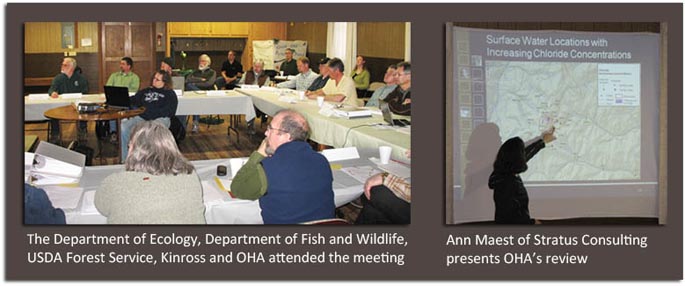Issues by Water Year: 2009
Out of Adversity Comes Opportunity
The 2009 annual coordination meeting to discuss the Buckhorn Mines took place at the Eagle Cliff Grange on the bank of the Kettle River on March 17th. Final monitoring reports were distributed to the agencies and OHA on March 3rd. OHA’s consultant, Ann Maest of Stratus Consulting, presented our review of the documents along with an independent review of the monitoring data. OHA offered recommendations regarding water treatment, streamflow comparison, capture zone, development rock, the Kettle River Facility, discharge monitoring reports and composite database as well as the timing of the next annual reports.
The purpose of the annual coordination meeting is to review the hydrogeologic and water quality monitoring of the mine and suggest modifications to plans that will help ensure protection of the environment.
WY 2009 Violations: Arsenic (December, January, April); Total Dissolved Solids (TDS) (May); ammonia (June); zinc (July); chlorine (July)

Cleaner Reports, Cleaner Water… but concerns remain regarding certain missing and faulty data and analysis
This year’s evaluation is based on Water Year (WY) 2009, which began on September 31, 2008 and ended on October, 1, 2009. WY 2009 reports were much improved over last year’s reports. The reports were well organized and for the most part addressed the issues directly, spelling out the requirements early.
Shortly after last year’s annual meeting, numerous violations, orders and a $40,000 fine were issued to Kinross/Crown for various water quality violations and failure to maintain the mine’s capture zone. The violations and orders continued until August when improvements to the Water Treatment Facility were implemented. Since that time no violations have been issued.
Summary Findings
- Water Treatment Plant improvements and approach were positive – more improvements needed
- A number of sites are adversely affected by underground mine and/or treated water releases; WY 2010 will show if improved; none of the levels are alarming
- No large decreases in streamflows, but methods for estimating changes and meteorologic data need improvement
- Groundwater capture has not been demonstrated – seasonal variability in groundwater levels overwhelms drawdown signal at many of the wells
More information can be found on pages 4-5 of the April 2010 Buckhorn Bulletin Newsletter, with updates, issues, and recommendations regarding:
- Water Treatment Plant (WTP)
- Water Quality Issues
- Development Rock
- Evaluation of Mine Dewatering Impacts to Streamflow
- Capture Zone
- Kettle River Tailings Facility
Draft Modification NPDES Permit
2009 also brought a draft modification NPDES, which involved some serious water quality issues:
On May 14, 2009, Washington State Department of Ecology issued a draft modification NPDES (National Discharge Elimination System) permit and fact sheet.
The purpose of the modification was:
- To add monitoring for chlorine to the NPDES. Chlorine would be used to reduce unexpectedly high levels ammonia.
- To add some aspects of OHA’s settlement agreement to the permit such as increasing surface water monitoring during April, May, and June for turbidity and Total Dissolved Solids from monthly to bi-weekly for monitoring sites SW-7, 8, & 9 downstream on the east side of the mine and at three sites on Marias Creek Rd.
- To add grease and oil monitoring for water in and out of the treatment facility, the lack of which was an oversight from the original permit.
- To add another round of chronic and acute testing since the first one was not conclusive.
Issues:
There was no disclosure of the impacts of increased chlorine on aquatic organisms. The public has a right to know the impacts of decisions before they are made. OHA asked that Ecology show that adding chlorine to the environment would be less harmful than other methods of reducing ammonia levels such as biological treatment, artificial wetlands or adding additional zeolites to the treatment facility. OHA also asked that an AKART (All Known and Reasonable Technology) be done.
The engineering report for this NPDES modification was approved in February 2009 and included a modification of the point of discharge of Outfall 002 from the storm water infiltration pond to from a pipe at the top of riprap on the hillside above Gold Bowl Creek. Ecology had wrongly considered this change in discharge point a minor modification since the change has previously caused erosion and slope instability, in violation of permit limits and so not covered under 40CFR122.63. There was no documented justification or cause for not using the stormwater pond to infiltrate discharge of Outfall 002.
The effluent failed the acute toxicity testing if any aquatic test organism has less than 80% survival in 100% effluent. The toxicity tests conducted in September 2008 showed no survival (100% dead) in 100% effluent. Based on these results, additional monitoring should have taken place but did not.
The modification failed to include other provisions of OHA’s settlement monitoring that are west of the mine. According to the settlement agreement water quality monitoring similar to NPDES requirements will be conducted on SW-5, 10, & 11 also. OHA asked that these monitoring points also be included in the modified permit.
Detection limits for a number of toxic metals were too close to, or in some case even higher than, relevant standards. OHA asked that these detection limits be lowered and included in the permit and monitoring reports.